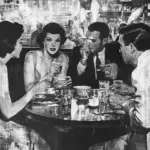Blood holds profound symbolic and practical significance across cultures, often occupying a unique position between gift and commodity. This duality reflects deeper societal values and highlights modern societies’ complex relationship between altruism, economics, and health.
Blood as a Gift
In many cultures, blood donation is viewed as a supreme act of altruism. The notion of blood as a gift is deeply rooted in cultural and religious beliefs that emphasise selflessness and community solidarity. Blood is seen as a life-giving substance, and donating it is considered a noble act of saving lives.
This perspective is particularly evident in voluntary, non-remunerated blood donation systems. In his seminal work “The Gift Relationship,” Richard Titmuss argued that treating blood as a freely given gift leads to a safer, more efficient, and morally superior blood supply system. This view aligns with cultural narratives that frame blood donation as a civic duty and a way to contribute to society.
In India, for example, religious gurus have played a significant role in promoting blood donation as a sacred ritual and an expression of devotion. This cultural framing has been instrumental in overcoming initial scepticism about Western medical practices and increasing donation rates.
Blood as a Commodity
Contrasting with the gift paradigm is the view of blood as a commodity. This perspective is most apparent in systems where donors are compensated for their contributions, particularly in plasma donation. The global plasma industry, valued at around US$24 billion, relies heavily on paid donations.
The commodification of blood raises ethical questions and practical concerns. Critics argue that it may exploit vulnerable populations and potentially compromise the safety of the blood supply. In the United States, for instance, many individuals living below the poverty line depend on income from selling their plasma.
Cultural Variations and Implications
Cultural perceptions of blood vary significantly across societies:
- Ownership and Identity: Some cultures view blood as personal property, while others see it as a universal substance. This affects attitudes towards donation and transfusion.
- Kinship and Family: In many cultures, blood symbolises family ties. This can lead to a preference for donating blood to family members rather than strangers.
- Religious and Spiritual Beliefs: Blood often holds spiritual significance, influencing donation practices. Some religions encourage donation as an act of charity, while others may have restrictions.
- Social and Racial Dynamics: In some contexts, blood donation intersects with issues of race and social equality. For example, in post-apartheid South Africa, changes in blood donation policies have been linked to broader social reconciliation efforts.
Resolving the Gift-Commodity Tension
The tension between viewing blood as a gift or a commodity has practical implications for blood collection systems. Some researchers propose a “double altruism” approach, where donors can choose to direct their compensation to charitable causes. This model attempts to maintain the moral high ground of altruistic donation while providing incentives to increase supply.
Conclusion
The cultural perceptions of blood as both gift and commodity reflect broader societal values and tensions. While the gift model aligns with ideals of altruism and community, the commodity model addresses practical needs for increasing blood supply. Understanding these cultural dynamics is crucial for developing effective and culturally sensitive blood donation systems to meet growing global health needs while respecting diverse cultural perspectives.
As we navigate these complex issues, it’s essential to consider how blood donation systems can be designed to honor the spirit of giving while ensuring an adequate and safe blood supply for all who need it. This may involve innovative approaches that bridge cultural divides and address both the symbolic and practical aspects of blood in modern healthcare systems.
https://nomadit.co.uk/conference/easa2012/paper/7813/paper-download.pdf
https://futurumcareers.com/blood-sect-and-fears
https://www.ncbi.nlm.nih.gov/pmc/articles/PMC8458749/
https://www.tandfonline.com/doi/full/10.1080/01459740.2023.2187295
https://www.ncbi.nlm.nih.gov/pmc/articles/PMC4997900/
https://www.sapiens.org/culture/blood-plasma-donation-gift-commodity/
https://www.ncbi.nlm.nih.gov/pmc/articles/PMC5665255/
https://journals.plos.org/plosone/article?id=10.1371%2Fjournal.pone.0188765
https://www.jstor.org/stable/90012088

